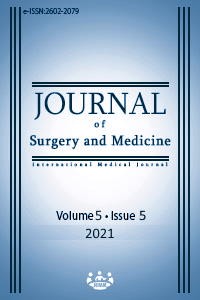Evaluation of the relationship between polysomnography parameters, physical examination findings and oxidative stress parameters in patients with obstructive sleep apnea syndrome
Keywords:
Obstructive sleep apnea, Oxidative stress, RhinomanometryAbstract
Background/Aim: Oxidative stress status in obstructive sleep apnea syndrome (OSAS) is well discussed in the literature. Oxidative stress levels increase, and antioxidant system activi-ty decreases in OSAS patients. However, the change in oxidative stress status in positional (pOSAS) and non-positional (npOSAS) OSAS has not been adequately examined. The aim of this study was to compare OSAS patients’ polysomnographic (PSG) parameters and oxidative stress capacities with the structural and functional properties of the upper respiratory tract. Methods: This study was designed as prospective case-control study and patients were divided into three groups as control, pOSAS and npOSAS according to their PSG findings. Ear nose throat examinations including rhinomanometry test and oxidative stress blood parameter tests were conducted to all patients. Variables among the groups were compared. Results: All PSG parameters were significantly worse in the OSAS groups than the control group (P<0.05). The mean AHIs of the pOSAS and npOSAS groups were 21.7 (16.5), and 31.2 (21.9), respectively. AHI, desaturation number and minimal SpO2 values of the pOSAS group were significantly lower compared to the npOSAS group (P=0.043, P=0.017 and P=0.006, respectively). TNF α was significantly lower and adiponectin was significantly higher in the pOSAS group compared to the npOSAS group (P=0.001, P<0.001 respectively). The two groups were similar in terms of rhinomanometry results (P=0.888). Conclusion: The lack of difference between pOSAS and npOSAS patients in terms of rhinomanometry results may indicate that the nose may not play a decisive role in the differentiation of these groups. Only OSAS severity may not be a determinant factor in oxidative stress balance in patients with pOSAS and np OSAS.
Downloads
References
Lawrance KS. ASDA- Diagnostic Classification Steering Committee. The International Classification of Sleep Disorder. Diagnostic and Coding Manuel, 2nd ed.Chicago: Allen Press Inc;1997. s. 52-8.
Ravesloot MJL, White D, Heinzer R, Oksenberg Arie, Pepin JL. Efficacy of the New Generation of Devices for Positional Therapy for Patients With Positional Obstructive Sleep Apnea: A Systematic Review of the Literature and Meta-Analysis. J Clin Sleep Med. 2017;13:813-24. doi: 10.5664/jcsm.6622.
Cartwright RD. Effect of sleep position on sleep apnea severity. Sleep. 1984;7:110–4.
Yingjuan M, Siang WH, Leong Alvin TK, Poh HP. Positional Therapy for Positional Obstructive Sleep Apnea. Sleep Med Clin. 2019;14:119-33.
Al Mutairi S, Mojiminiyi OA, Al Alawi A, Al Rammah T, Abdella N. Study of leptin and adiponectin as disease markers in subject with obstructive sleep apnea. Dis Markers .2014;2014:706314. doi: 10.1155/2014/706314.
Bozkurt H, Neyal A, Geyik S, Taysi S, Anarat R, Bulut M, et al. Investigation of the Plasma Nitrite Levels and Oxidant-Antioxidant Status in Obstructive Sleep Apnea Syndrome. Noro Psikiyatr Ars. 2015;52:221-5. doi: 10.5152/npa.2015.7607.
Arısoy A, Ekin S, Sertoğullarından B, Günbatar H, Sünnetçioğlu A, Aksoy N, et al. The Relationship Among Oxidative and Anti-oxidative Parameters and Myeloperoxidase in Subjects with Obstructive Sleep Apnea Syndrome. Respir Care. 2016;61:200-4. doi: 10.4187/respcare.04277.
Ursavas A, Ilcol YO, Nalci N, Karadag M, Ege E. Ghrelin, leptin, adiponectin, and resistin levels in sleep apnea syndrome: Role of obesity. Ann Thorac Med. 2010;5:161-5.
Faul F, Erdfelder, E, Lang AG, Buchner A. G*Power 3: A flexible statistical power analysis program for the social, behavioral, and biomedical sciences. Behavior Research Methods 2007;39:175-91. doi: 10.3758/BF03193146.
Oksenberg A, Silverberg DS, Arons E, Radwan H. Positional vs nonpositional obstructive sleep apnea patients. Anthropomorphic, nocturnal polysomnographic and multiple sleep latency test data. Chest 1997;112:629–39. doi: 10.1378/chest.112.3.629.
Lavie L. Oxidative stress and endothelial dysfunction in obstructive sleep apnea. Front Biosci (Elite Ed) 2012;4:1391-403. doi: 10.2741/469.Yıldırım T, Alp R. The role of oxidative stress in the relation between fibromyalgia and obstructive sleep apnea syndrome. Eur Rev Med Pharmacol Sci. 2017;21:20-9.
Argüder E, Parlak EŞ, Kılıç H, Hezer H, Neşelioğlu S, Hasanoğlu HC, et al. Thiol-disulfide as a novel indicator of obstructive sleep apnea. Clin Respir J. 2020;14:652-8. doi: 10.1111/crj.13180.
Cofta S, Winiarska HM, Płóciniczak A, Bielawska L, Brozek A, Piorunek T, et al. Oxidative Stress Markers and Severity of Obstructive Sleep Apnea. Adv Exp Med Biol. 2019;1222:27-35. doi: 10.1007/5584_2019_433.
Qingsheng Li, Zheng Xin. Tumor necrosis factor alpha is a promising circulating biomarker for the development of obstructive sleep apnea syndrome: a meta-analysis. Oncotarget. 2017;8:27616-26. doi: 10.18632/oncotarget.15203.
Kleisiaris CF, Kritsotakis EI, Daniil Z, Tzanakis N, Papaioannou A, Gourgoulianis KI. The prevalence of obstructive sleep apnea‐hypopnea syndrome‐related symptoms and their relation to airflow limitation in an elderly population receiving home care. Int J Chron Obstruct Pulmon Dis. 2014;9:1111‐7. doi: 10.2147/COPD.s67779.
Ming H, Tian A, Liu B, Hu Y, Liu C, Chen R, et al. Inflammatory cytokines tumor necrosis factor-ɑ, interleukin 8 and sleep monitoring in patients with obstructive sleep apnea syndrome. Exp Ther Med. 2019;17:17661770. doi: 10.3892/etm.2018.7110.
Nadeem R, Molnar J, Madbouly EM, Nida M, Aggarwal S, Sajid H, et al. Serum Inflammatory Markers in Obstructive Sleep Apnea: A Meta-Analysis. J Clin Sleep Med. 2013;9:1003-12.
Bingöl Z, Karaayvaz EB, Telci A, Bilge AK, Okumuş G, Kiyan E. Leptin and adiponectin levels in obstructive sleep apnea phenotypes. Biomark Med. 2019;13:865-74.
Wysocka E, Cofta S, Dziegielewska S, Gozdzik J, Torlinski L, Batura-Gabryel H. Ad-ipocytokines in sleep apnea syndrome. Eur J Med Res. 2009;14:255–8.
Downloads
- 308 575
Published
Issue
Section
How to Cite
License
Copyright (c) 2021 Abitter Yücel, Hamdi Arbağ, Fuat Yöndemli, Sebnem Yosunkaya, Mehmet Kayrak, İbrahim Kılınc
This work is licensed under a Creative Commons Attribution-NonCommercial-NoDerivatives 4.0 International License.
















